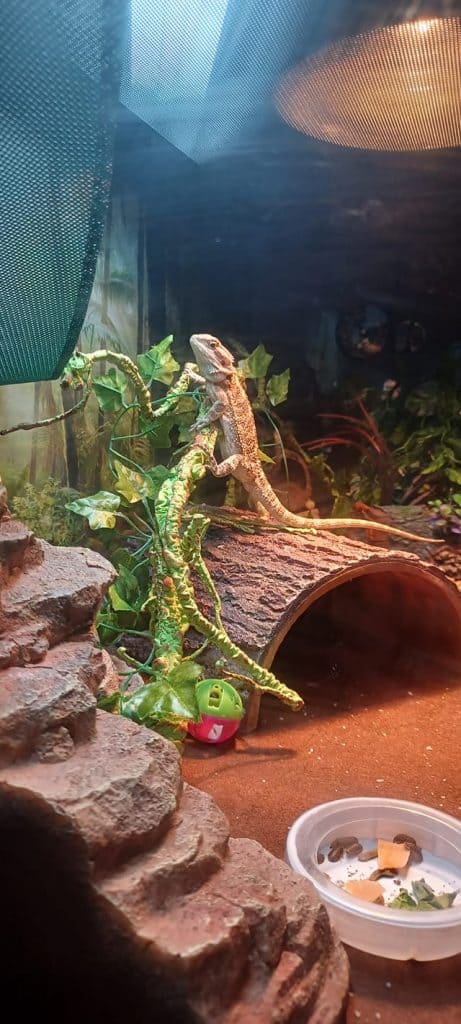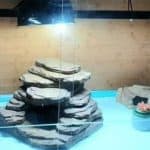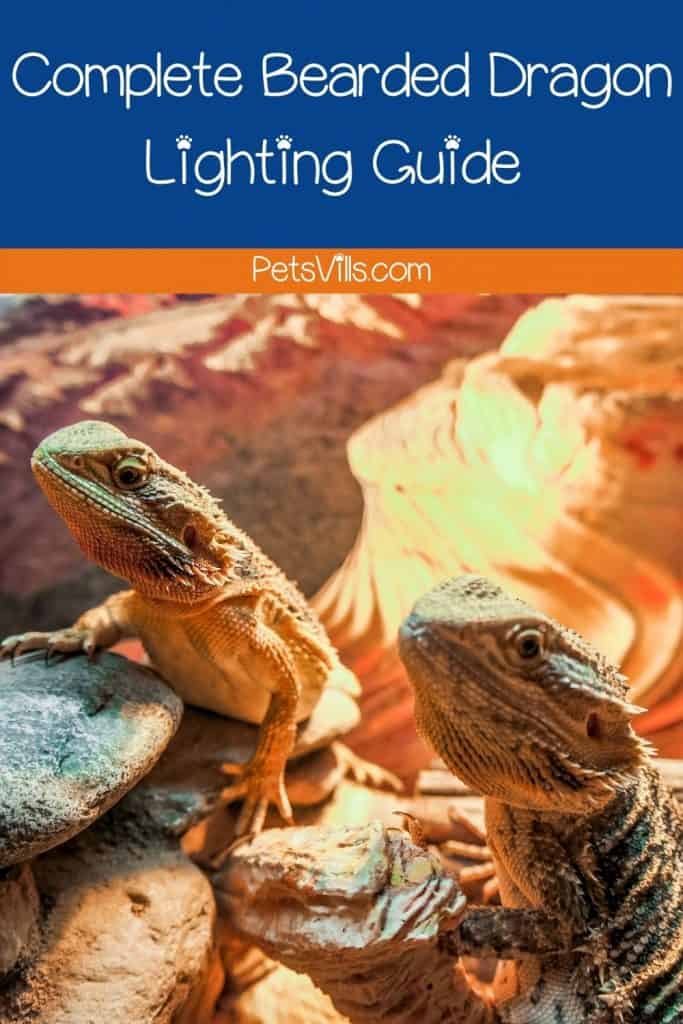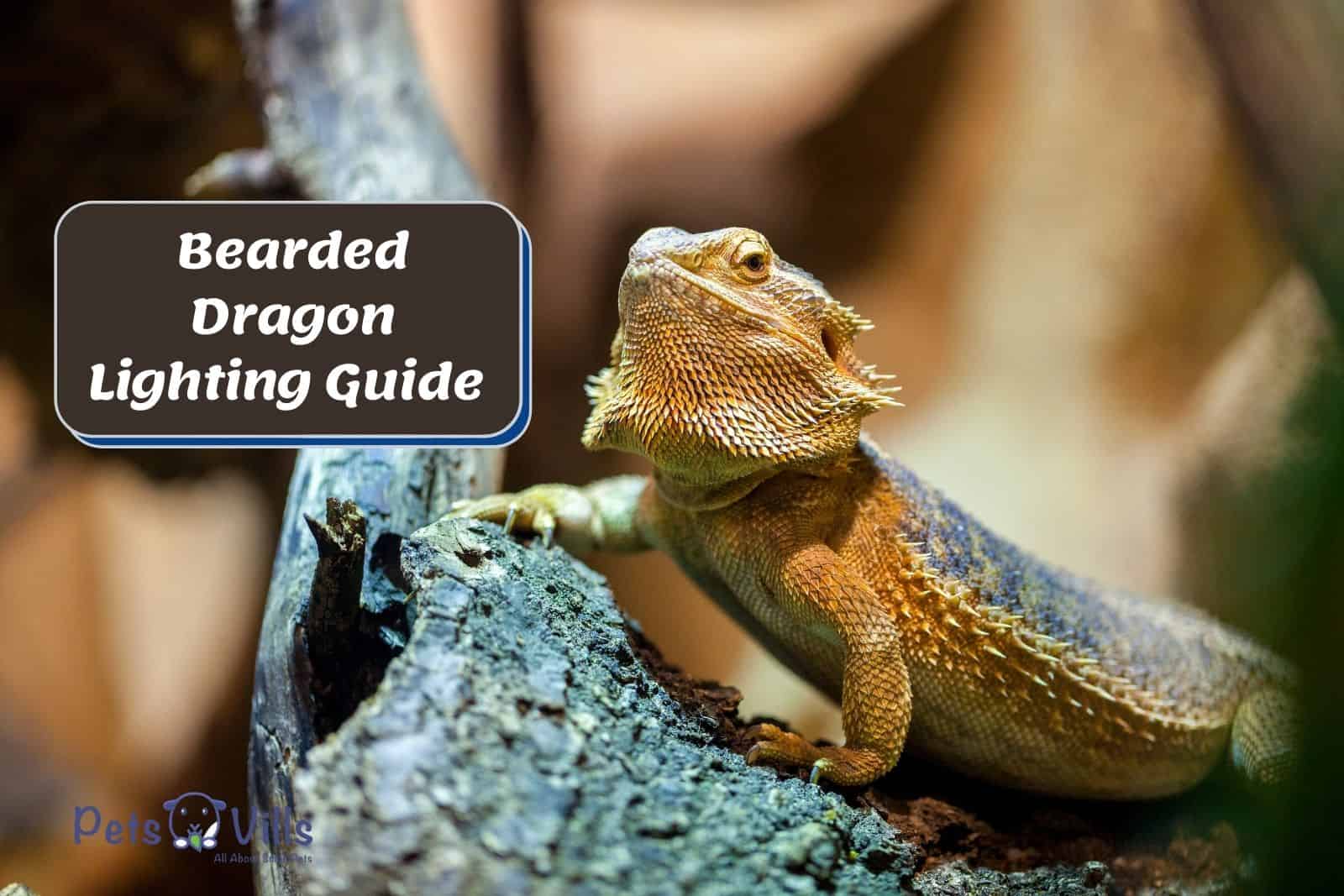Understanding how your bearded dragon setup should be can be difficult. Luckily, as an expert and a beardie owner myself, I will share with you the correct dragon lighting guide.
Continue to read for more details.
FYI, this post contains affiliate links, and I will be compensated if you make a purchase after clicking on my links.
Table of Contents
What Light Should I Use for My Bearded Dragon?
Most newbie parents do not know the correct light and heat emitters to pick. A bearded dragon needs two types of light in captivity:
- UVB light
- Basking light (a source of UV radiation)
The two lamps above provide the necessary heat and light that replicate the arid Australian desert environment.
A good UVB light source that I can recommend would be the Zoo Med Repti-Sun 10.0 UVB Compact Fluorescent Light.
Here is a video with more insight that explains which light to consider.
Importance of UVB light for a Bearded Dragon
Remember that UVB light is important to bearded dragons because it helps them synthesize vitamin D3, which helps in calcium absorption.
Insufficient amounts of UVB exposure will lead to Metabolic Bone Disease (MBD) [1] in bearded dragons.
MBD is the weakening of bones in a bearded dragon because of the lack of vitamin D3 nutrients. When MBD is not addressed correctly or at the appropriate time, beardies risk dying.
So, always provide and maintain a consistent supply of UVB to a bearded dragon. Beardies should not go over two days without UVB radiation.
Is Basking Light as Important as UVB?
As a beardie owner myself, I have installed basking lights in my pet’s tank. Basking light provides enough UV rays for all reptiles and most amphibians — and bearded dragons are no exception to this.
These particular lizards not only need basking light to warm up or regulate their day and night cycle. A bearded needs basking light to regulate their metabolism, help in digestion, and absorb nutrients.
Typically, a bearded reaches its thermal maximum temperature at 95–110◦F [2]. When they reach thermal maximum temperatures, they will open their mouth (a process known as gaping).
Note that, when gaping, a beardie needs a cool zone to regulate its body temperature. This is why having a cool zone in the tank is important.
If a bearded does not bask sufficiently, it risks suffering from impaction. Impaction is a condition that results from food not digesting properly and getting stuck in the beardies digestive system.
You should at least leave the basking light on for about 12–14 hours a day. This is the correct amount of time a pet bearded absorbs sufficient radiation and reaches its thermal maximum body temperature.
What is the Right Watt Bulb for Bearded Dragon?
Again, remember that the number of watts should correspond to the size of the tank/vivarium/terrarium. A 100 watts bulb, for instance, is ideal for large tanks (> 40-gallon tank).
A higher wattage bulb is ideal for tanks larger than 40-gallons. For much larger tanks that are over 150 gallons, place 2 UVB bulbs.
I will mention the best UVB bulb for bearded dragons in this article if you are not sure of what particular brand to consider.
But the correct wattage bulb should be anywhere between 75 to 100 watts.
Pro-Tip: Do not install a bulb that is over 150 watts in a bearded tank. You risk burning the bearded skin.
Remember that not all bulbs that produce light produce the same amount of warmth. There are specific bulbs for specific functions.
But not to worry because I will share with you how to pick the best bulbs for specific roles.
Check out this video. You will find more information about the correct watts for your reptile friend.
UVA Light for Bearded Dragon
UVA light has a longer wavelength than UVB light. UVA is important to stimulate the beardie’s appetite.
You wouldn’t want a pet that has a bloated stomach or has trouble feeding.
What to Look for in a UVA Lighting Fixture
Over the years, I have taken care of bearded dragons, and I have some advice for new parents.
I will briefly share with you 2 considerations before picking a UVA light fixture.
Compatibility: This means the bulb fits the tank precisely without having to install additional hanging brackets or mounting add-ons.
Always understand the size of the tank before purchasing a UVA lighting fixture.
Temperature: Always consider a UVA bulb that produces the recommended temperature. You will find the recommended temperature for a bearded tank as you continue to read this article.

Lights Needed for Bearded Dragon
Picking the wrong fixture has its negative effects on a beardie’s health. Apart from the natural sunlight, beardies need specific visible light.
Bearded require sufficient UVA and UVB light. At least 7–10% of UVA and UVB radiation. Most parents think that beardies only require UVB radiation. Which is not the case altogether.
UVA light: This particular radiation helps stimulate the beardie’s appetite and keeps it healthy.
UVB light: This type of radiation helps in the metabolism of calcium and vitamin D3 in the beardie’s body. UVB is considered the backbone of bearded wellbeing.
Basking light: As the name suggests, basking lights are essential to help your pet beardie to thermoregulate efficiently. This particular light also helps to maintain appropriate temperature levels in bearded dragons.
Replacing the Bulbs
In my research, I came across a question from one beardie owner who wants to know when to replace the bulbs.
“I want to replace her UVB bulb [3] because I’m not sure how old the current one is since it was in the enclosure when we bought it. He put in a 10.0 but I feel like that’s a bit strong since she also spends a lot of time pretty close to it on the higher branch. Like 6 inches from the light. But it’s a 4x2x2 so maybe 10.0 is necessary? But can’t too much UVB also hurt them?”
Note that after 6 or 12 months, the UVB bulb becomes ineffective to a bearded. Hence, replace a UVB bulb after every 6 to 12 months.
To be precise, replace a T8 ReptiSun 10.0 UVB lamp after every 6 months and a T5 ReptiSun 10.0 UVB lamp after every 6 or 12 months.
T5 ReptiSun lamps are somewhat weaker than the T8 ReptiSun UVB bulb.
As an expert, I normally recommend this pattern to all pet bearded owners.
RELATED: Can Bearded Dragons Get Too Much UVB?
Proper Bearded Dragon Light Setup
A terrarium needs to be set up correctly. You should know where to place the bulb, the correct distance of the bulb to the tank, and how to set up a cool and hot zone.
Watch this video to understand more about how to hang UVB light in tank.
Setting Up a Basking Lamp
In the wild, beardies like to bask under the sun for extended periods. Thus, replicate the same conditions for your pet beardie in captivity.
Apart from installing hiding spots and other artificial accessories for your pet beardie, a bearded tank should have a hot and cool zone in its tank. The size of the tank should match the type of basking lamp.
The correct basking zone should stretch ⅔ to ¾ of the tank. The cool-off zone should stretch ⅓ or ¼ of the tank.
Similarly, you can use a regular bulb as a basking light for your pet bearded. I recommend installing halogen bulbs that range between 40 to 100 watts.
For a 40 gallon tank, I would recommend a 100 watts bulb. The basking light should produce approximately 35º to 40º C (95º to 105º F).
It can be overwhelming to pick the precise basking light for your beardies tank. I use 75 watts halogen bulbs for my bearded when she is bromating or during the winter months.
The basking lamp and UVB lamp should be positioned in one corner, leaving enough room for the “cool spot” on the other side of the tank.
Check out more details I have covered about the appropriate temperatures for the beardies enclosure.
I prefer the UVA basking spot daylight heat lamp. It is efficient and produces enough UVA radiation.
If you are confused about how to mount a basking lamp, here is a video to make you understand more.
Distance of the Basking Light
The ideal distance of the basking light varies with the particular bulb fixture. Before installing a basking light on the beardies tank, you should always read the bulb’s recommendations.
Some bulbs produce higher gradient heatwaves and should be placed over a foot high from the tank.
Other basking bulbs can produce weaker radiations over time and should be placed closer to the tank. Not exceeding 1 foot away.
Give your beardie unfiltered radiation. Do not place a lamp over the plastic screen cover or glass.
I wouldn’t recommend these six basking lights.
- Reptile white spotlight.
- Red bulbs.
- Moonlight bulbs.
- Bright lights or soft white light.
- Hot rocks.
- Coil lamps.
Best Heat Bulbs for Your Bearded Dragon
Not all heat bulbs are appropriate for a bearded dragon. Some produce excess heat while others produce insufficient radiation.
So, which are some of the best heat bulbs for a beardie during the cold months?
Here are three ideal options I know of and have personal experience working with. You can, however, find more alternatives in this link.
Zoo Med ReptiSun 10.0 UVB Mini Compact Fluorescent Lamp produces 10% UVB output and 30% UVA output. An ideal radiation amount for your pet bearded.
Zoo Med ReptiSun 5.0 UVB Mini Compact Fluorescent Lamp produces 5% UVB output and 30% UVA output.
Ceramic Heat Emitters (CHE): Heating Solution
Always consider CHE the same way the sun provides natural UV light and heat. You could be using bulbs that do not produce optimum light and heat as the sun.
Ceramic Heat Emitters are also ideal for providing ideal heat in the bearded enclosure. Usually when the temperatures have dropped below the recommended degrees.
What degrees are appropriate? Normally, I use ceramic heat emitters in the winter months to keep my pet’s enclosure warm and maintain the recommended 70º–75º F temperature.
Also, remember that ceramic heat emitters can be positioned anywhere on the bearded dragon tank setup. These particular fixtures are only necessary to produce heat (increase temperature gradient) but not UVB light.
- The ideal temperature for baby bearded is 35º to 43º C (95º to 110º F)
- The cool zone should be around 24º to 27º C (75º to 80º F)
Tip: Switch off the heat emitter at night to allow your bearded to sleep comfortably. In the wild Australian desert, the temperatures range between 61º and 70° F.
You should also mimic these temperatures for your bearded in captivity.
Here are the best ceramic heat emitters I would recommend to you.
- OMAYKEY 100W 2-Pack Ceramic Heat Lamp: This is my top choice.
- Fluker’s Ceramic Heat Emitter For Reptiles: This heat emitter is ideal for all types of reptiles.
- Simple Deluxe Ceramic Heat Emitter: Best Budget-Friendly Ceramic Heat Emitter.
- LUCKY HERP Reptile Ceramic Heat Emitter: An effective choice to consider.
- ZACRO Reptile Heat Ceramic Lamp (Non-Light): Best For Thermal Efficiency.
Also, you can check out this video to understand more about how to choose the correct bulb for your pet bearded.
Bonus tips: I personally do not recommend using red lights on the tank. Not because red lights are strange to the bearded.
Red lights can actually affect the bearded dragon’s vision. Also, red lights affect the sleep cycle [4] of bearded dragons.
You can also use dome reflectors on UVB bulbs to increase the light intensity focusing on the beardie.
Bearded Dragon Lighting Cycle
Bearded dragons are diurnals. This means that they are active during the day and sleep at night.
In the wild, bearded bask during the day and retreat to their hideouts at night to sleep. Thus, I suggest following the same rhythm and pattern for your bearded in captivity.
A scheduled rhythm is important to give your dragon both physical and mental arrangement.
Turn the daytime light/heat on for 12 hours and turn it off for another 12 hours at night.
Setting up a thermal gradient environment
A bearded tank should not miss a thermal gradient setup. Thermal gradient setup, for new beardie owners, is the difference in temperature levels from the hot zone to the warm zone to the cool zone.
The gradient should run horizontally for effective results.
Ideal thermal temperatures and lighting conditions during brumation
Brumation [5] is the process by which a beardie slows down its metabolism to preserve its energy.
Most bearded dragons brumate during the cold season. However, some don’t. During this time, you will notice unusual behavior in your beardie.
You will notice a loss of appetite and signs of lethargy in your bearded, for instance. Other signs, like avoiding direct light and extended sleep time, can also be noticeable.
In the wild, bearded dragons will receive reduced amounts of light during winter. So, you need to mimic the same conditions to keep your beardie as natural as possible.
Brumation often lasts about 3 months. During these months, make sure you reduce the amount of food and temperatures gradually (by reducing the basking hours).
You can also reduce the watts significantly. Adjust the temperature to about 8-10 hours in a day. However, constantly check the temperatures inside the tank to make sure they receive the recommended amounts.
Battery-powered heat lamps are the way to go if you completely want to deal with a power outage.
Also, clock timers are ideal in the bearded’s tank setup.
5 Lighting Guide Quick Reference
- Providing 12–14 hours of sufficient UVB radiation is recommended.
- 10–14 hours of UV basking radiation is also appropriate for your pet bearded.
- 95º–110º F for basking area is ideal.
- 75º–80º F for the cool zone is highly recommended.
- Lights off at night for about 12 hours each day.
FAQs
Is it okay to turn the daytime light off at night?
Yes. It is recommended to turn the basking light and UVB light off at night.Turn it off for about 12 hours per day.
What kind of light is appropriate for my bearded dragon?

Full-spectrum UV lights like ReptiSun, incandescent electric lighting bulbs, mercury vapor lamps, and ceramic bulbs are appropriate for bearded dragons.
What length is appropriate for UVB lighting?
UVB lights should extend 2/3 or 3/4 of the tank. Leave the rest of the space for your pet beardie to cool off.
What’s the appropriate position to place the light?
Position the lamp directly over the tank. However, there should not be any glass or plastic blocking the rays from reaching inside the tank. Do not position the bulb sideways.
How much light for my pet bearded is ideal?

Bearded dragons require about 12 to 14 hours of sufficient UVB lighting in a day. 8 hours of sufficient light in the summer months is highly recommended.
Conclusion
You probably did not know that a bearded dragon lighting setup was as complicated as you have seen.
Know the appropriate distance & ideal position to place the lamp in the tank, understand the lighting schedule, and identify the appropriate bulbs to use.
This guide helps you understand everything a beardie needs (concerning lighting) in its environment. Follow the setup process to give your pet the best and most comfortable environment there is.

What do you think of this bearded dragon lighting guide? Let us know below!
References
- 1. Axelson R. Bearded Dragons – Diseases [Internet]. VCA Hospitals. 2009. Available from: https://vcahospitals.com/know-your-pet/bearded-dragons-diseases
- 2. Wissman MA, DVM, DABVP. Bearded Dragon Basking Open Mouth – Reptiles Magazine [Internet]. Reptiles Magazine. 2012 [cited 2022 Mar 1]. Available from: https://reptilesmagazine.com/bearded-dragon-basking-open-mouth/
- 3. Massie V. Facebook. 2021. Available from: https://www.facebook.com/groups/1392934904420521/permalink/1548600782187265/
- 4. Are Red Lights Bad For Bearded Dragons? – Neeness [Internet]. Neeness. 2021 [cited 2022 Mar 1]. Available from: https://neeness.com/are-red-lights-bad-for-bearded-dragons/
- 5. Doneley B, Health A, Toowoomba W. EXOTICS – REPTILES AND AMPHIBIANS – 1607 CARING FOR THE BEARDED DRAGON [Internet]. 2006. Available from: https://www.cabi.org/ISC/FullTextPDF/2006/20063121821.pdf
Alina Hartley is a small-town girl with a ginormous love of bearded dragons. It all started with Winchester, a baby bearded who was abandoned at the shelter by his former owners because of a birth defect that caused one front leg to be shorter than the other. Alina originally went to the shelter looking for a guinea pig, but one look at Winchester and it was love at first sight. From that day on, Alina has dedicated her life to learning everything she can about bearded dragons. She loves helping new beardie parents start their incredible journey with these magnificent reptiles.
Follow her on:
LINKEDIN
TWITTER.
Read her latest articles HERE
Learn more about her HERE.


